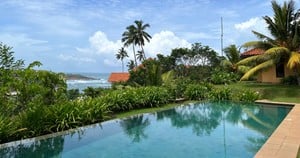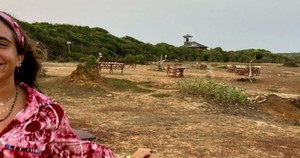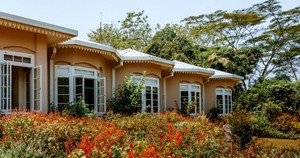- 3 September 2022
Discovering Sri Lanka
If you’ve seen Sri Lanka in the headlines in recent months, you’re probably aware that the country has been sinking deeper into the worst economic crisis it has ever seen. The capital, Colombo, has seen months of protests due to rising food prices and fuel shortages as the Sri Lankan people are tired of the economic mismanagement by the government and are demanding change. In the midst of all the chaos on the news, it’s easy to forget that the media tends to highlight the negative and rarely the positive. We must remember that Sri Lankans are united and protesting peacefully for a worthy goal, and do what we can to support them.
If you’ve seen Sri Lanka in the headlines in recent months, you’re probably aware that the country has been sinking deeper into the worst economic crisis it has ever seen. The capital, Colombo, has seen months of protests due to rising food prices and fuel shortages as the Sri Lankan people are tired of the economic mismanagement by the government and are demanding change. In the midst of all the chaos on the news, it’s easy to forget that the media tends to highlight the negative and rarely the positive. We must remember that Sri Lankans are united and protesting peacefully for a worthy goal, and do what we can to support them.
The country was massively shaken by Covid-19, as its economy is largely reliant on tourism, so when restrictions hit, many small businesses didn’t survive, and Sri Lanka as a whole started drowning in insurmountable debt. Now that everything has opened up, they are still picking up the pieces and trying to recover from a complete economic collapse. And we can help them.
Tourism is critical to the Sri Lankan economy. It is the way out of the country’s economic crisis and locals and residents are strongly urging tourists to come back to their beautiful island. And they are! Tourists continue to flock to Sri Lanka despite how the situation is being portrayed online because it’s still an incredible place and there is actually no risk to tourists.
I had no idea what to expect leading up to my trip to Sri Lanka. I didn’t know anyone who had visited the country and I had never even seen it on my social media feeds; I was going in blind. After spending a week on the island, I can confidently say it is a hidden gem of Asia, but the word “gem” doesn’t even measure up to how beautiful the country is. I came back feeling like I had this big secret I couldn’t wait to reveal to the world.
The Resplendent Ceylon journey typically starts with Ceylon Tea Trails, then Wild Coast, and finally Cape Weligama. But I did it in reverse, and I recommend you do it in reverse, too.
Cape Weligama
As we were checking into Cape Weligama, I blinked and my bags were next to me. I knew at that moment that the service at Resplendent Ceylon was going to be exceptional. (I was right.) 39 suites occupy 12 pristine acres, designed in a way that simulates a traditional Sri Lankan village. Once you know your way around, walking the grounds actually feels like you’re just strolling around your neighborhood. To me, the resort is designed in a way that everything on Earth should have been built: harmonious with its surroundings and designed to adapt to the land it was built on. The property doesn’t erase the ecosystem that lived on the grounds; it co-exists with it. Tall, wild palm trees surround you on all sides and indigenous monkeys and peacocks live in harmony with the guests and staff. The flora and fauna that lived on the territory before the resort was built are largely undisturbed by it.
The hotel sits on a cape, so no matter where you are, you have a breathtaking view of the sea and the surfers who ride its chaotic Sri Lankan waves. Leave the white noise machine at home, the wind and crashing ocean will be the soundtrack of your entire stay. Sri Lanka is an amazing surfing destination, with some of the best waves on Earth, no matter the season. The hotel offers surfing classes, so even if you’ve never surfed in your life, it’s an amazing opportunity to try it out in one of the top surfing destinations in the world.
In order to get to the ocean, you have to leave the hotel property and take a short walk (~3 minutes) to Jungle Beach. In Sri Lanka, you can’t actually privatize beaches, so the surrounding beaches are raw and untouched by any development. When I got to Jungle Beach, I felt like I was interrupting some kind of ritual. There were about four other people there, and they were all completely frozen, looking out into the waves in total silence. No one was speaking, playing music, reading, or doing anything. Just observing and taking it all in. It was eerie and magical at the same time, I still tear up thinking about it. Words cannot describe how unforgettable this moment was.
I spent the majority of my time at Cape Weligama like the people on the beach: observing my surroundings and taking it all in. With the sea, the greenery, and the animals, I couldn’t look away even to check the time. Social media didn’t exist, the world outside of Cape Weligama didn’t exist, and all my responsibilities melted away. I truly embraced island living, walking around in a swimsuit, sarong, and flip-flops all day, no matter what time it was or where I was going, and I didn’t open my makeup bag once. Coming from Dubai, it was such a healthy break from the city’s fast pace, its unattainable beauty standards, and of course, its crush of concrete. We all know nature is healing and offers so many benefits to your mental health, but the energy on Cape Weligama is next level. I can’t explain why, but it was grounding and restorative in a way I’ve never felt before.
Wild Coast Tented Lodge
All of us on the trip had the same sentiment leaving Cape Weligama: how can it possibly get better than this? We knew we had two more incredible locations to get to, and our first two days were so phenomenal we literally couldn’t imagine what we were in for for the rest of the week. We headed to Wild Coast Tented Lodge with heavy hearts, but so excited for what was to come.
Wild Coast redefines the “safari” concept as more than daily game drives. It’s a holistic wilderness experience that lets you get up close and personal with the wildlife. Every aspect of your experience at the lodge is mindful of the surrounding environment, even the meals are inspired by nature and the freshness of local produce.
The resort is adjacent to Yala National Park, the second largest national park in Sri Lanka, and sits on a wild, virgin beach overlooking the Indian Ocean. The water is lawless, with massive waves that smack against the rocks on the shore to create an uprush so forceful that it feels like a predator that’s about to attack its prey. It was a source of entertainment for us, especially during our daily post-evening game drive cocktails on the beach, or “sundowners”, where we said goodbye to another memorable day in the wilderness.
There are no borders or barriers surrounding the property, which means you can be lounging by the pool with monkeys or get a special visit from some enormous creatures if you’re lucky. Sometimes entire families of majestic elephants pass through the lodge and the hotel lets cautiously allows them to continue their path uninterrupted.
You even get your own safari experience from the comfort of your room, as the cocoons are actually structured around watering holes built on the grounds, positioned in the shape of a leopard’s paw print (Yala is renowned for its leopard population). Each watering hole is tiered to provide different water depths and access locations for the wildlife, with nesting trees planted around them for local bird species, so you can see visitors of all shapes and sizes – from elephants and buffalo to peacocks and pelicans – while sitting on your private deck overlooking the pond.
“This is their land, we are here temporarily,” is a phrase you’ll hear a lot at the lodge. There is a big focus on sustainability. Given the resort’s proximity to wildlife, every design aspect keeps the surrounding ecosystem in mind. The lighting at night is dim, ensuring that the animals are not disturbed. The cocoons (a.k.a. suites) are designed to come apart at a moment’s notice, ready to be disassembled and removed leaving nothing behind.
The Lodge is especially invested in its zero waste policy in all sectors of management from water to food, and even energy. All the wastewater is recycled to feed the ponds and water the gardens, the air conditioning units serve a dual purpose by generating hot water for the room, and 30 percent of the resort runs on solar power. The kitchen is also on its way to zero waste, with any remaining food waste either sent to livestock farms in the area or used to produce an impressive amount of biogas which is used to fuel the staff kitchens. Did someone say circularity?
This is so impressive for a hotel. I often see vague sustainability reports from hotels about how they’re kinda reducing their plastic use (usually with paper straws, groundbreaking), but there is a clear and genuine intention to protect the environment and actively ensure nothing goes to waste at Wild Coast.
Ceylon Tea Trails
Did we save the best for last? I think so. For our final stop, we took a 30-minute seaplane from the Wild Coast to the highlands, enjoying bird’s eye views of the diverse Sri Lankan landscape and lush, misty tea estates, landing right in front of Tea Trails’ Summerville Bungalow on Castlereagh Lake. Ceylon Tea Trails is made up of five restored historic tea planter residences dating back as far as 1888, called bungalows. Each bungalow is individually designed to suit its heritage, and each one is more stunning than the next. It was impossible to pick a favorite.
I arrived thinking that this has to be one of the most beautiful places on Earth, so beautiful that it doesn’t feel real. Visiting Tea Trails was like traveling back in time and entering some kind of Narnia, where you completely disconnect and lose yourself in time.
We stayed in Tientsin Bungalow, named after the Chinese village where original tea seedlings came from. Fun fact: legend has it that in 2737 BC, a Chinese emperor was about to take a bath underneath a tree, and after some leaves blew into his bath water, he decided to try the infusion and, you guessed it, discovered tea. (When a Sri Lankan asks you if you know the story, say no. They love to tell it to you.) Not only is the scenery breathtaking, but the bungalow itself is also beautifully decorated, incredibly cozy, spotless, and quietly luxurious. Tennis courts, croquet, lush gardens, and black and white pictures of Sri Lanka and tea plantations on the walls very much give that “old money tastefulness” that makes you feel like you’re a guest in the home of your (extremely) wealthy friend, who just happens to live in an ethereal garden paradise.
During your stay, you can take the active approach and mountain bike through the hills, kayak on the lake, and climb Adam’s Peak, or you can choose to enjoy the absolute quiet and spend your days being pampered and observing life on a working tea estate. I sat somewhere in the middle. I opted out of alarms and instead woke up to a hummingbird tapping on my window. I spent my days wandering the tea fields, visiting the century-old tea factory on the estate, and reading and journaling in the gardens. I highly recommend exploring the fields during your time there, either follow the trail outlined by the hotel or book a guided tour for a longer journey, you might be able to spot the resilient leopards going about their days. The closest we got was a very fresh paw print I spotted in the mud.
Some background on the leopards: tea plantations honestly weren’t a good thing for them. When the estates were established, the leopards’ habitats were destroyed by deforestation and as a result, human-leopard conflicts became a rising issue, especially in the villages sitting between the plantations. But, Resplendent Ceylon is actively helping resolve the issue. Tea Trails partnered with the Wilderness and Wildlife Conservation Trust to create a corridor, called the Peak Ridge Corridor , to increase connectivity between the leopards’ habitats through reforesting and regenerating some of the territories they lost. Since it was implemented, there has been a noticeable decrease in human-leopard conflicts and approximately 20 leopards are being monitored through cameras for their safety and the safety of the villages.
For me, the highlight of the stay was the staff and their outstanding service. Clement, Samantha, and the team went above and beyond to meet our every need and pay attention to every detail, right down to placing a tea leaf on our pillows during their turn-down service. They welcomed us into the bungalow saying, “This is not a hotel, this is your home,” and it really was. It was the type of care you receive from your family. I left Tea Trails with the same emotions I would feel leaving my grandparents’ house after the holidays. There may have been tears involved.
By Jana Shakhashir for Savoir Flair

Extended Stay Savings
Extend your stay for 6+ nights at Cape Weligama, save more and enjoy the holiday of a lifetime.



















